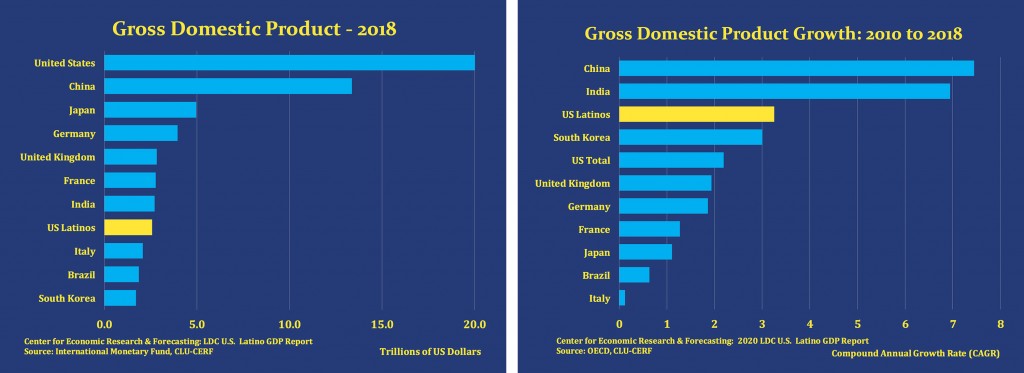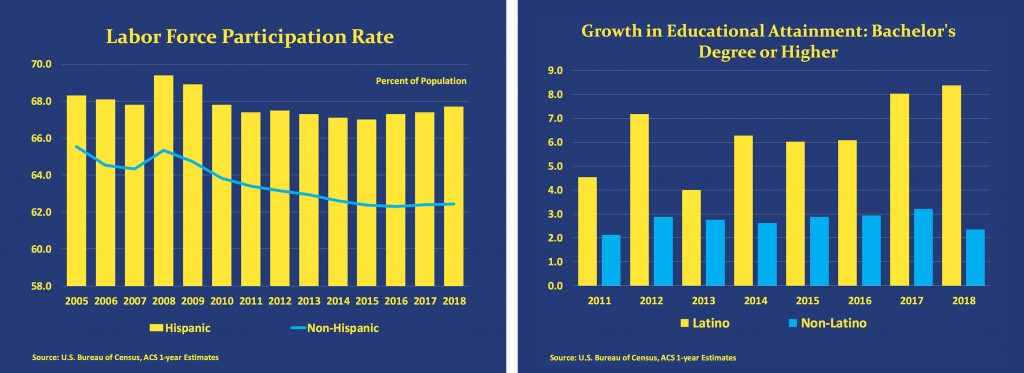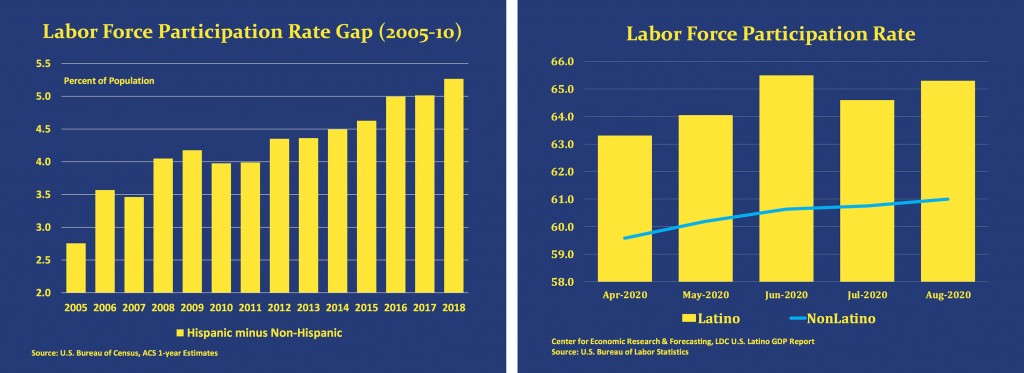CERF Blog
EXECUTIVE SUMMARY
The 2020 LDC U.S. Latino GDP Report seeks to provide a factual view of the large and rapidly growing economic contribution of Latinos living in the United States. We estimate the U.S. Latino GDP based on a detailed, bottom-up construction which leverages publicly available data from major U.S. agencies. The most recent year for which the core building block is available is 2018. Thus, this year’s report provides a snapshot of the total economic contribution of U.S. Latinos in that year.
As a summary statistic for the economic performance of Latinos in the United States, the 2018 Latino GDP is breath-taking. The total economic output (or GDP) of Latinos in the United States was $2.6 trillion in 2018, up from $2.3 trillion in 2017, and $1.7 trillion in 2010. If Latinos living in the United States were an independent country, the U.S. Latino GDP would be the eighth largest GDP in the world. The Latino GDP is larger even than the GDPs of Italy, Brazil or South Korea.
While impressive for its size, the U.S. Latino GDP is most noteworthy for its extraordinary growth rate. Among the world’s 10 largest GDPs in 2018, the Latino GDP was the single fastest growing.Latino real GDP grew 21 percent faster than India’s and 30 percent faster than China’s.Over the entire period from 2010 to 2018, the Latino GDP is the third fastest growing, while the broader U.S. economy ranks fifth.
The economic contribution of Latinos is a tremendous engine of economic growth within the United States. Latino GDP grew 72 percent faster than non-Latino GDP from 2010 to 2018 and nearly 350 percent faster from 2017 to 2018.
The single largest driver of rapid Latino GDP growth since 2010 is personal consumption. From 2010 to 2018, Latino real consumption grew 133 percent faster than non-Latino consumption. This dramatic increase is driven by large gains in personal income, which naturally flow from Latinos’ rapid gains in educational attainment and strong labor force participation. Whereas the U.S. had average wage and salary growth of just 5.1 percent over the previous five years, wage and salary growth for Latinos averaged 8.6 percent. From 2010 to 2018, growth in the number of people with a bachelor’s degree or higher was 2.6 times more rapid for Latinos than Non-Latinos. And Latino labor force participation in 2018 was 67.7 percent, more than five percentage points higher than non-Latino.
We note again this year that the importance of labor force growth cannot be overstated. According to Federal Reserve economists, the number of people retiring in the U.S. is forecasted to increase substantially over the next two years, peaking in 2022 at close to 350,000 mostly non-Latino Baby-Boomers retiring each month.
This dangerous shortage of workers is a demographic crisis which threatens the country’s ability to maintain even modest economic growth. Fortunately, Latinos are already well on their way to rescuing the U.S. from this demographic time bomb, adding substantial numbers to the critical category of working age adults. Despite being only 18.3 percent of the U.S. population, Latinos are responsible for 78 percent of the growth of the U.S. labor force since the Great Recession.
Latinos provide a very large and positive demographic punch through both the addition of workers and the formation of households. The number of Latino households grew 23.2 percent from 2010-18, while the number of Non-Latino households grew just 3.8 percent. This is especially astounding given that average Latino household size is also much larger. A healthy rate of household formation is vital to economic growth, as new households increase current and future economic activity.
The family values, hard work and persistence of U.S. Latinos are not only an engine of economic growth, they are a bright spot during an extraordinary year of economic upheaval.
Early evidence from the coronavirus recession of 2020 indicate that Latinos will be a driver of economic recovery. Monthly data show a dramatic contraction of the U.S. labor force resulting from government-mandated shutdowns beginning in March. The data also indicate a stunning recovery in at least one corner of the U.S. Labor market.
From April to June, as government-mandated closures were beginning to lift, Latino Labor Force Participation soared at a rate more than double the rate of Non-Latinos.
Using the Financial Crisis and Great Recession as a reference point, we expect the gap between Latino and Non-Latino Labor Force Participation to widen during the recovery, and we expect Latino perseverance and hard work to once again be a source of resiliency for the U.S. economy. During the darkest days of the Financial Crisis and Great Recession, the gap between Latino and Non-Latino Labor Force Participation surged, increasing fifty percent from 2005 to 2009 and rising continuously from 2010 to 2018. As we’ve argued for two years now, this correlates strongly with the growth of the Latino GDP. And it points to what we can expect following the current crisis.
Latinos are one of the economy’s biggest growth engines, and the pandemic is making this even more true than ever.
Download the full report: 2020 LDC U.S. Latino GDP Report




